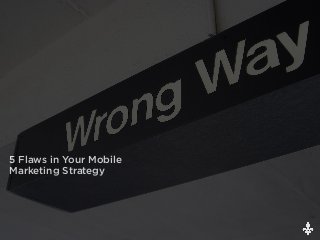
5 Flaws in Your Mobile Marketing Strategy
- 1. 5 Flaws in Your Mobile Marketing Strategy
- 2. The hyper-connected consumer of today has little patience for clutter or noise. His smartphone is the compass with which he engages the world, the persistent interface that guides him through the ever- evolving digital landscape.
- 3. How then, as marketers, do we evolve in order to not only keep pace with the mobile revolution, but also to utilize it as intended?
- 4. The smartphone is intensely personal, intimately integrated into our social graphs, superior in its contextual awareness of time and space, hyper- connected and nearly always within arm’s reach.
- 5. The smartphone has, in essence, become a natural extension of our human selves.
- 6. Yet, despite the newfound wealth of opportunities available to mobile marketers, we have been consistently and fundamentally flawed in both strategy and execution. Quite simply put, we’re doing it all wrong.
- 7. 1. Flaw: De-Emphasizing the Unique Nature of the Medium
- 8. Although they share a common infrastructure, mobile is not the traditional web. In fact, the two have few equivalents in the stationary web world.
- 9. The stationary web is exactly that – inactive. With that said, why would mobile design, which should be focused on creating an experience unique to those who are actively on-the-go, be constructed with an inactive model in mind?
- 10. Mobile events are inherently transitive in nature. The different elements of the medium — constant connectivity, location awareness, personalization and social connection — add affinity to consumer/brand interactions and empower the medium uniquely as an events-driven interface.
- 11. These features form the foundation for consumer interaction — a tight, relevant orchestration of branded communications among increasingly interconnected brand advocates.
- 12. 2. Flaw: Treating Connected Consumers as Stationary Targets
- 13. Mobile consumers are moving targets; therefore, marketers must consider the variability of exchange.
- 14. Where is the consumer right now? What is she interested in? How can I compel her to visit my store location? What can I reward her with to increase her loyalty to the brand? How can I use the medium to make her encounter the brand more efficient? What experience can I provide to her that she would feel compelled to share?
- 15. When viewed through this lens, the possibilities for engaging consumers are limited only to the imagination and ingenuity of the brand.
- 16. 3. Flaw: Ignoring the Power of Contextual Relevance
- 17. The mobile medium represents the most powerful mechanism for delivering contextually relevant, consumer-brand marketing communications. To take advantage of its unique capabilities, however, successful marketing strategies must evolve alongside these communicating customers.
- 18. The digital natives of today’s hyper-connected world seek contextual relevance when engaging with brands. Their experiences are defined not only by the message itself, but by the context in which the message is presented.
- 19. Marketers who effectively tackle today’s mobile variables will provide consumers with unique experiences that are differentiated, highly relevant and intensely personal. Only then will we collectively realize the power and influence of marketing in the moment.
- 20. 4. Flaw: Employing Old World, Unidirectional Communications Strategies
- 21. Effective consumer engagement can no longer take an unidirectional mindset. Today’s digital natives are constantly presented with a dizzying array of branded digital touchpoints. They are expecting consistent yet unique communication and brand message.
- 22. Brands are now challenged to become adept transmedia storytellers, to create a message that syncs with the communication medium in which it’s delivered.
- 23. Brands must move beyond simply marketing to people but, instead, must master marketing to a context that is determined by device or platform. They must consider the specific medium which they choose to engage.
- 24. 5. Flaw: Not Offering Value in Exchange for Value
- 25. Establishing consumer relationships through mobile marketing, as with any successful relationship, inherently requires a mutual exchange of value.
- 26. Regardless of the strategies or technologies employed, successful mobile marketing relies heavily on a fair and evenly balanced value exchange between consumer and brand.
- 27. Without the perception that value is mutual, the relationship becomes essentially one-sided and unrequited. The customer may attempt to end the relationship — perhaps permanently.
- 28. In Conclusion
- 29. Given the intensely personal nature of smart devices, coupled with the fact that the device is nearly always within arm’s reach, it becomes extremely important that mobile marketing avoids being intrusive and irrelevant.
- 30. Conventional marketing wisdom advocates a right audience + right message + right time methodology, designed to entice a stationary audience. In mobile, the same principles don’t necessarily apply.
- 31. Rather than marketing at the target with brand-centric storytelling, wherever and however she may encounter you, allow the tale to travel along with her as she goes.
- 32. Communicate the narrative, allow the mobile medium to reveal ensuing chapters in a continuum of branded engagements.
